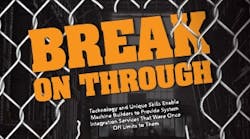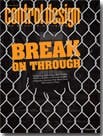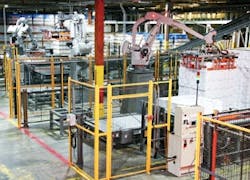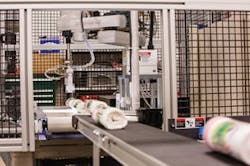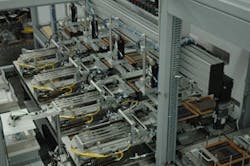Some end users are capable of performing their own system integration, but their numbers seem to be in decline as facilities continue to run lean. Others turn to system integrators or engineering firms for help, but many end users instead call on their robot and machine-builder OEMs for help with system integration for a variety of reasons.
Dan Hebert is senior technical editor for Control, Control Design and Industrial Networking. Email him at [email protected] or check out his Google+ profile.
SEE ALSO: Surpassing System Integration
OEMs Bring Expertise
What do OEMs know about integrating their equipment with existing production lines, automation systems and software platforms? Quite a lot, as it turns out.
"When multiple machines are needed for a variety of coordinated processes, ARC will help design the logistics of the production flow and the production line layout," says John Martin, vice president of engineering at ARC Specialties, a robot and machine builder in Houston. "We custom-design production lines based on whether customers want production to be fully automatic, semi-automatic or manual. For example, a customer might want a system with semi-automatic part loading, like a crane loading a pipe onto a gravity-fed pipe rack with an automatic singulator, fully automatic welding, automatic out-feed conveying and manual unloading." For more about ARC's qualifications and experience as a systems integrator, see the sidebar "OEM Excels at System Integration."
-
OEM Excels at System Integration
- Packaging Integration Expertise
Matt Wicks, vice president of controls and software engineering at Intelligrated, in Mason, Ohio, explains his company's integration strengths: "We're a builder of conventional and hybrid palletizers, and we manufacture a wide variety of other types of material handling equipment, such as conveyors, sortation products and robotic tooling (Figure 1). In addition to the equipment we manufacture, we have an extensive software offering, which we draw on when we develop and integrate material-handling solutions. Our customers leverage our products as well as our integration expertise to develop the best solutions."
Wicks says that because his company is an equipment builder it understands its products and how and where these products should be applied best, while it avoids integrator/supplier conflicts by providing the right solution the first time. "This knowledge is translated back into the product development cycle to streamline the integration process, which drives down overall costs and implementation schedules," Wicks adds.
Muthuraman Ramasamy, research analyst for Frost & Sullivan sees a trend toward outsourcing integration, often in favor of OEMs. "The industry is heavily gravitating toward a one-stop solution due to the decline in the skilled workforce and its inability to retain a relevant workforce in-house," Ramasamy notes. "This drives them to depend on solution providers for integrated solutions and not just piecemeal products. Some of the advantages of using an OEM are an integrated solutions approach, comprehensive risk management, reduced maintenance expenditures and improved operational efficiencies."
Figure 1: Intelligrated is an OEM providing services such as installing its Alvey robotic layer depalletizing system and integrating it with other material-handling equipment, such as this Intelligrated chain-driven live roller pallet conveyor.
Source: Intelligrated
Gary Kirckof, system engineering group manager at Beckhoff Automation, also sees the trend. "Many of Beckhoff's OEMs provide integration services to their clients, and the requests for these services are increasing," he notes. "This is because many manufacturers find it more difficult to integrate capital equipment as they often don't have the resources necessary to do the job efficiently and cost-effectively. Manufacturers increasingly draw on the skills and expertise held by the OEMs in projects that resemble those commonly handled by traditional system integrators."
One of Beckhoff's OEMs is Bosch Packaging Technology in New Richmond, Wisc. Bosch has gone into the system integration business in a big way. Paul Garms, product manager, says the company has even given its system integration expertise a name — Module++.
"Our product portfolio breadth and experience in the market makes it likely that we've worked with a similar product, and can use this experience to help create the right packaging line solution for each customer," Garms points out. "We also understand the capabilities of our equipment and the optimal strategy for feeding and integrating each machine. This knowledge results in automation solutions that dependably achieve high overall equipment effectiveness (OEE)." The sidebar, "Packaging Integration Expertise," provides more details on Module++ and how Bosch Packaging Technology uses its expertise to integrate packaging machines.
Automating Specialized Machines
Machine OEMs are extremely qualified to handle system integration of specialized machinery and applications because they often work exclusively or extensively in a particular industry.
USNR, an OEM of wood-processing equipment in Woodland, Wash., makes nearly every piece of machinery found in a modern wood-processing plant. This equipment performs tasks ranging from panel and plywood processing to manufacturing lumber, fingerjointed components and glulam beams. "USNR provides complete automation solutions that can start from a single machine center all the way to integrating an entire modern sawmill," explains Paul Strebig, controls engineering manager. "These systems can encompass more than 30 machine centers and cover an area larger than two football fields."
Delta Computer Systems supplies the electro-hydraulic motion controllers used by USNR. Bill Savela, product manager at Delta, says USNR typically supplies all the mechanical equipment, controls and optimization systems in a complete package. "An OEM such as USNR has more than a century of experience in serving the needs of individual customers in the forest products industry," Savela notes.
Figure 2: This packaging automation system designed by CMD integrates a SCARA robot with a single-roll gripper assembly capable of inserting more than 1,650 rolls of garbage bags into retail or bulk packaging boxes per hour. The system removes out-of-spec rolls, ensuring product uniformity and reducing bottlenecks.
Source: CMD
In specialized industries, system integration not only requires knowledge of the machines themselves, but of the industry as well. CMD in Appleton, Wisc., is a manufacturer of converting equipment for the blown-film and flexible packaging industries (Figure 2). "OEMs typically have a very thorough understanding of the equipment and processes involved to provide the best solution," says Chris White, project manager at CMD. "Many times when an outside integrator steps in to integrate multiple pieces of equipment, they'll not fully understand the manufacturing process. Without a very thorough understanding of the process involved to produce the product, system efficiencies can be negatively affected."
SEE ALSO: Beware Third-Party Integration
Owens Design in Fremont, Calif., is an OEM of equipment for the electronics industry. "We build all types of production tools, including those used for wet processing, metrology, precision assembly, substrate-handling automation and vision inspection," says Bob Fung, vice president of engineering. "We use many off-the-shelf automation components along with a variety of robots that are integrated into our systems. We also build custom systems when required, design the controls and write the software for all tools that we build."
Production lines for leading-edge products often require custom automation to meet the new and unique requirements of the new application, Fung adds. In one large production line (Figure 3), several of the assembly stations required integration of equipment from several suppliers along with custom mechanisms and complex vision guidance.
When Owens builds a system, it tests it thoroughly. "We have a production line on our shop floor that has 24 robots, 30 vision cameras and 20 CPUs, with 12 different process steps with specific staging," Fung says. "We also have a strong engineering group that designs tools for our customers that they can't find anywhere else."
As an OEM, Owens can afford to build and support this extensive in-house test facility, as can others.
Increasing Expertise
Machine OEMs often develop extensive system integration capabilities in-house to meet the needs of customers. "ARC Specialties controls every aspect of a project including the design and integration of control systems and software for each system," Martin explains. "For manufacturing processes requiring multiple robots or automated machines, ARC created centralized control systems that coordinate all the processes performed by these multiple units."
Figure 3: OEM Owens Design integrated a mixture of internally designed components and off-the-shelf robotics to optimize performance of this off-axis solar processing tool.
Source: Owen Design
White says CMD's goal is to provide solutions to its customers. "To provide total solutions effectively we must be very capable of integrating our equipment with upstream and downstream processes," he says. "This allows single-source accountability for end users and provides them with a vertical start-up."
Fung notes that Owens Design has a very experienced engineering and program-management group with strong design backgrounds. "Our engineers average more than 20 years experience in the area of complex tool design and build," he says. "We have the ability to apply critical design expertise as needed to provide the optimal solution. Having this in-house expertise positions us to offer superior tool design and installation support."
Andrew Pringle, OEM commercial manager at Rockwell Automation, deals with OEMs every day, and he observes that advanced automation helps drive the OEM-as-integrator trend. "The evolution from using PLCs with digital I/O to having a fully connected enterprise spurs more OEMs to offer integration services," he explains. "Networks enable greater bandwidth and access to production data. With deep knowledge of their machinery, OEMs can recommend the best ways for users to take full advantage of that data, and convert it into actionable insights."
Another factor that drives customers to demand integration services from their OEMs is a desire for single-source responsibility, or "one throat to choke," suggests Tom Jensen, program manager of OEM business development at Lenze.com. "The advantage an OEM integrator provides to a plant is that there is only one name you have to remember if there is an issue: the OEM. Another benefit is that many times the integration comes as part of a package. If you can afford the line, the installation support sweetens the pot."
But the business models differ, Pringle adds. "Many OEMs find that the financial benefits of offering integration outweigh the added risk; however, some might not."
The Opposing View
As you might expect, some system integrators and engineering firms are not happy about OEMs encroaching on their territory and question whether or not OEMs are qualified to do the work. Criticisms include poor overall system documentation, the high cost of being required to use the OEM's equipment and an inability or unwillingness of OEMs to integrate machines and robots with high-level software such as ERP, MES and CMMS systems.
We'll cover the systems integrator and engineering firm side of the story in an upcoming article.
